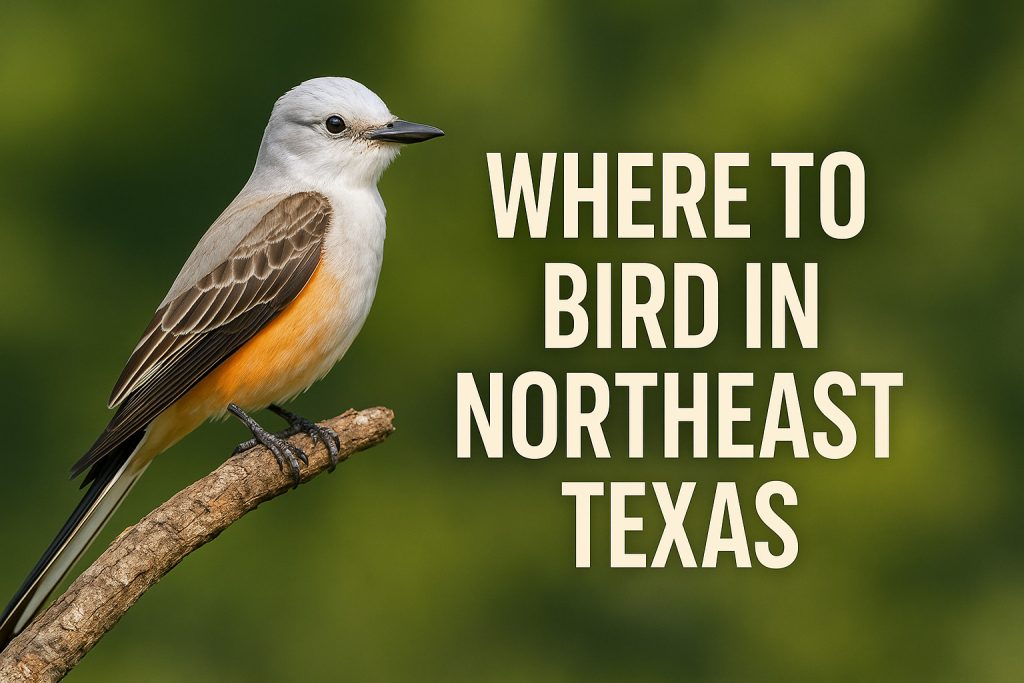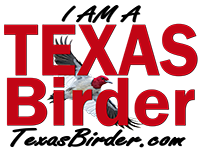
Before you grab your binocs and chase that next lifer, just a quick note: this list highlights some of the most popular birding locations in the region, with only the basics to get you started. Think of it as a beginner’s guide for your next birdy road trip. We’re working on adding even more locations, juicy details, seasonal tips, and probably a few “you had to be there” birder stories. And hey—if you’re out exploring Texas, keep an eye out for Michael in the Texas Birder camper. He’s crisscrossing the state one birding hotspot at a time, likely parked under a tree with a notebook, a camera, and an opinion about vireos.
Let’s get one thing straight: if you think Texas birding starts and ends with the Hill Country and the Gulf Coast, allow me to gently hoot at you like a Barred Owl at midnight. Because tucked away in the piney woods, wetlands, lakes, and winding country roads of Northeast Texas is one of the state’s most underrated birding regions.
Whether you’re looking for Painted Buntings showing off, Bald Eagles doing Bald Eagle things, or a hundred warblers trying to drive you pleasantly insane in spring migration—this corner of the Lone Star State delivers.
So grab your binocs, throw your field guide in the backseat, and let’s go birding in Northeast Texas!
1. Lake O’ the Pines
Location: Straddling Marion, Upshur, and Morris counties
Habitat: Mixed pine-hardwood forest, open water, cypress sloughs
Birding Hotspots: Lakeside Village, Alley Creek Park, Johnson Creek, and the dam overlook
What You’ll See:
- Bald Eagles (often nesting near the lake)
- Ospreys, herons, and egrets galore
- Winter ducks like Bufflehead and Hooded Mergansers
- Woodpeckers that sound like a percussion section warming up
Why It’s Great:
Lake O’ the Pines is one of those places where you can scan open water for diving ducks and turn around and watch a Red-headed Woodpecker land on a pine tree. Also, this is Bald Eagle central in winter—so much so that it has its own Facebook group.
2. Daingerfield State Park
Location: Morris County, near Daingerfield
Habitat: Deep pine forest with a spring-fed lake
Birding Hotspots: Around the lake trail, CCC-built structures, and the hardwood groves
What You’ll See:
- Wood Thrush and Hooded Warblers in summer
- Brown Creepers and Golden-crowned Kinglets in winter
- Barred Owls hooting like they’re at a karaoke contest
- Flycatchers flitting through the understory
Why It’s Great:
It’s like birding in a forest cathedral. The towering pines echo every call, and the trails are easy to walk and loaded with possibility. Also, the WPA-era architecture and lake views are easy on the eyes.
3. Old Sabine Bottom Wildlife Management Area
Location: Northeast of Tyler in Smith County
Habitat: Bottomland hardwood forest, seasonal wetlands, sloughs
Birding Hotspots: The main trails and anywhere water meets woods
What You’ll See:
- Prothonotary Warblers lighting up the swamp like tiny yellow lanterns
- Northern Parulas singing their buzzy songs in spring
- Wood Ducks gliding silently through shadowy backwaters
- Possibly a birder or two crying happy tears (true story)
Why It’s Great:
It feels like you’re stepping into a nature documentary, complete with dripping Spanish moss and echoing birdsong. Spring is the golden hour for this place, especially if you like warblers (and who doesn’t?).
4. Martin Creek Lake State Park
Location: Rusk County, near Tatum
Habitat: Pineywoods mixed with lake edge and brush
Birding Hotspots: The nature trail, boat ramp area, and woodland edges
What You’ll See:
- Carolina Wrens yelling at nothing in particular
- Pine Warblers, Eastern Bluebirds, and the occasional Red-shouldered Hawk
- Belted Kingfishers making sure you know they’re there
Why It’s Great:
A peaceful, lesser-known park with lots of potential, especially during migration. It’s a great place to combine a relaxing walk with a chance to see something special.
5. Caddo Lake State Park and WMA
Location: Harrison County
Habitat: Bald cypress swamp, oxbow lakes, bayous
Birding Hotspots: Saw Mill Pond, Mill Pond Trail, canoe-accessible sloughs
What You’ll See:
- Barred Owls during the day (yes, daytime owls!)
- Pileated Woodpeckers pretending they’re dinosaurs
- Anhinga and Great Egret perched in that classic cypress pose
- Warblers dripping from the trees in April and May
Why It’s Great:
Caddo Lake is what happens when a swamp decides to become an art gallery. You’ll see incredible birds, sure—but the setting is half the experience. Kayak birding, anyone?
6. Mineola Nature Preserve
Location: Wood County, just south of Mineola
Habitat: Bottomland hardwoods, grasslands, wetlands, prairie restoration
Birding Hotspots: Birding bridge, Sabine River overlook, boardwalks
What You’ll See:
- Scissor-tailed Flycatchers in full drama mode
- Painted Buntings looking like someone turned the saturation up to 100
- Mississippi Kites cruising over the open fields
- 150+ species if you hit it right during migration
Why It’s Great:
It’s big, birdy, and built for birders. Tons of habitat diversity means you can see everything from meadowlarks to wading birds in a single trip. Plus, it’s stroller- and walker-friendly if you’ve got non-birders in tow.
Bonus: Other Local Gems
- Tyler State Park – Easy trails, pineywoods birds, and plenty of picnic tables to argue over field marks
- Hagerman NWR (just west of NE Texas) – If you want to see ducks like a boss and potentially hundreds of Snow Geese
- Lake Bob Sandlin State Park – Woodpecker central and a solid spot for migrants
Final Thoughts: Bird the Pines, the Prairie, and Everything Between
Northeast Texas might not get the birding spotlight like High Island or the Rio Grande Valley, but make no mistake—it’s a hidden treasure trove for birders in the know. Whether you’re leading a field trip, adding to your life list, or just chasing that elusive Northern Parula, this region delivers birdy joy in every season.
So go out there. Get muddy. Cry a little over a beautiful warbler if you need to.
And don’t forget to log your sightings on eBird—because we Texas Birders like to keep score (gently and respectfully, of course).

More Stories
Top Ten Best Places to Bird in Texas During September
Birding at Davis Mountains State Park in August: Cool Nights, Hot Days, and Surprising Birds
Where to Bird Near Dallas: Top Spots for Urban Birders and Wild Escapes